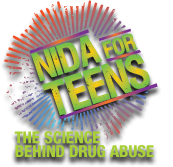Create a Classroom CSI
 Ever seen "CSI: Crime Scene Investigation" or one of the many awesome detective shows on TV? Not only are they fun to watch, but creating your own crime scene investigation is a great way to learn about the dangers of prescription drug abuse. The objective is to work your way backward through a story that you create with your peers or teachers, so that you and your friends can use the facts to figure out what happened. In working to solve the case, you will investigate all the possible factors that may have led up to the "crime scene." You and your peers can use this chance to talk openly about which drugs may be in the victim's system, why, and what other factors may have served as a motivation to abuse prescription drugs.
Ever seen "CSI: Crime Scene Investigation" or one of the many awesome detective shows on TV? Not only are they fun to watch, but creating your own crime scene investigation is a great way to learn about the dangers of prescription drug abuse. The objective is to work your way backward through a story that you create with your peers or teachers, so that you and your friends can use the facts to figure out what happened. In working to solve the case, you will investigate all the possible factors that may have led up to the "crime scene." You and your peers can use this chance to talk openly about which drugs may be in the victim's system, why, and what other factors may have served as a motivation to abuse prescription drugs.
Here's what you'll need:
- Creativity!
- A teacher's help
- Researchers to develop the clues and writers and a computer to draft the story and plan the scenario
- An actor to play the teen victim
- An actor to play the doctor or forensic scientist
- Actors to play the teen's parents
- Actors to play the teen's friends
- Investigators or detectives to examine the "crime scene" and figure out the victim's cause of death
- Props
- A camera and someone who will capture the event on film
Here's how to do it:
- Ask your teacher to host this event and make it a learning experience for you and your peers about the dangers of prescription drug abuse.
- Designate actors, researchers, investigators, and writers, and assign the necessary roles. Everyone can play a part.
-
Ask the writers to create a crime scene scenario. They should think of a real-life scenario to which you and your friends can relate. Share the script or story with a few other people so they can help keep the discussion going. When they write the script for your story, the writers should consider the following:
- The plot. We recommend starting it off with the story of a young person who dies or winds up in the hospital emergency room as a result of prescription drug abuse.
- Clues. Start asking your peers to think about what substance could have caused this teen's death or health condition. Then, determine what clues could help the investigators identify the substance of abuse. Have your designated researchers explore the facts about the substance you choose to feature in your scenario, and make the side effects and consequences as realistic as possible. Check out this site for the facts about prescription drug abuse and the side effects of commonly abused drugs.
- Details. How did the victim come into possession of the drugs? Why did he or she do it? What factors influenced his or her choices? How could this have been avoided?
- Lesson. Ask everyone to discuss what they've learned. What are the risks of using the drug you chose to include in the story? What can cause teens to use this drug? How can they say no when offered drugs?
- Give out some resources so your friends and peers can learn more about the dangers of prescription drug abuse. Refer them to the PEERx Website or the Sara Bellum Blog to get their questions answered, read about drugs in the news, and learn more about drug abuse prevention. Do a read-through. You and a few of your peers can create a script, reading certain sections at a time and guiding the discussion.
- After you do a dry run in your classroom, invite others from your school to come to your "crime scene" and solve the crime.
- After each scene, ask others to discuss what just happened and how the disastrous outcome of the featured scene could have been prevented. As your classmates get closer to figuring it out, act out the next scene and provide more clues.
- Students should discuss openly what may have happened to this person, and how he or she could have died. If students need more from a particular clue, the victim can speak to offer information about that clue, offering helpful hints that could lead to the next clue or help solve the mystery.
-
Can't think of a scenario? Here are a few ideas to get you started:
- Start at the end. A teen is in the hospital as a result of prescription drug abuse. Work backward to find out what drug the person took and whether he or she mixed it with other drugs or alcohol or took an excessive dose of prescription medications. Don't forget to include where he or she got the drugs.
- Show an older teen who now lives at home, is no longer in school, and doesn't have a job. Work backwards to reveal that, although the teen meant only to try the drug a few times with other friends, his or her friends all stopped using and moved on with their lives, while this person continued to abuse the prescription drug for the "high" and became addicted. What are the consequences for this person's actions? You decide. Focus on what this teen has missed as a result of this addiction.
Send Us Feedback
Have you tried this activity in your school or community? Send us feedback by downloading our feedback form [Word - 212 kb], filling it out, saving it, and emailing it to peerx@iqsolutions.com.




